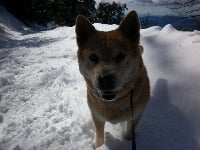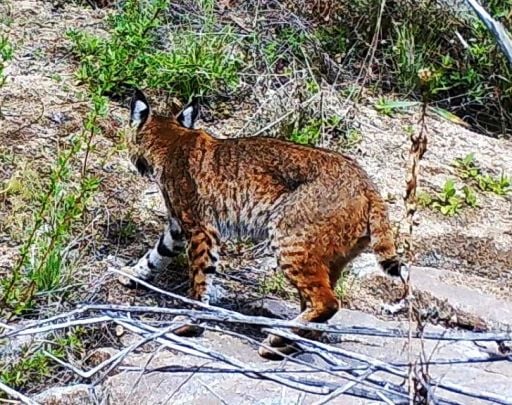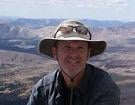Back in the day, when everything had a proper name, 4520' was called Panorama Peak. Presumably an eastbound trail took people from Switzer's Camp to a viewing platform atop the summit boulder.
Today that trail remains lost, but with some effort this peak can be accessed via its ridges. Walker and I took a variation of the west ridge route, starting from a toe on the north side.
It wasn't long before the loppers came out of our packs. In the years since the Station Fire heavy brush has reclaimed this area. We spent hours trimming branch after branch, moving very slowly up the steep slopes and ridge.
Some sections required scaling loose rocks and sand.
Fortunately the tough work led to great views around the Arroyo Seco.
Eventually the brushfest ended and the summit could be seen ahead with its distinctive cracked boulder.
Walker climbed the rock where the viewing platform once stood. Panorama was aptly named, as beautiful peaks and ridges pop out in all directions. To the south is the pinnacled ridge above Little Bear Canyon, and to the north stretches the high ridge between Josephine and Strawberry.
We found shade on the north side of the boulder and ate lunch. It ended up being a pleasant day, not too cold, not too hot. Occasionally a cool breeze reached us.
We took our final summit photos and then tried to retrace our route--for minimal bushwhacking experience. We got down in less than half the time it took to ascend. Water in the Arroyo Seco was flowing strong, and the picnic area was packed.
Switzer to Panorama Peak
-
Sean

- Cucamonga
- Posts: 4263
- Joined: Wed Jul 27, 2011 12:32 pm
You do not have the required permissions to view the files attached to this post.
-
walker

- Posts: 248
- Joined: Mon Apr 08, 2013 11:14 pm
Thanks for the great trip report, Sean. It almost feels like I went along for the trip as well--
If you cross your eyes while looking at the above, the two images will almost merge together and give you a splitting headache.
Wait a minute, I did go along for the trip! So I wasn't hallucinating after all! Here are some pics:
"Hey, Sean, I know a great way to go up Panorama Peak!"
Sean: "No problem!"
"Just a nice morning stroll in the park."
"Still crazy after all these years. / Keep on rockin' in the free world."
If you cross your eyes while looking at the above, the two images will almost merge together and give you a splitting headache.
You do not have the required permissions to view the files attached to this post.
-
Nate U

- Posts: 592
- Joined: Wed Apr 05, 2023 7:38 pm
If my false Panorama Peak / Tophat TR in any way played a part in inspiring this hike to happen, then I feel honored!
So cool to be able to reference that old photo. Where did you get it?
How common is it in the San Gabriels to have peaks with names lost to time? Were the San Gabriels more active with people in the past then they are now? So strange!
I've never used loppers before on a bushwack. Always been able to push my way through... but looks like you guys were in some pretty serious brush, I imagine more intense then anything I've ever encountered. I've mostly been in the Western area of the range, I'm guessing brush obstructions get denser and higher as you go east....
Is that 4711 I see poking up in the 2nd to last photo? Looks enticing...!
Let me know the next time you do something like this and wouldn't mind company, if I'm available I'd be down. ?
So cool to be able to reference that old photo. Where did you get it?
How common is it in the San Gabriels to have peaks with names lost to time? Were the San Gabriels more active with people in the past then they are now? So strange!
I've never used loppers before on a bushwack. Always been able to push my way through... but looks like you guys were in some pretty serious brush, I imagine more intense then anything I've ever encountered. I've mostly been in the Western area of the range, I'm guessing brush obstructions get denser and higher as you go east....
Is that 4711 I see poking up in the 2nd to last photo? Looks enticing...!
Let me know the next time you do something like this and wouldn't mind company, if I'm available I'd be down. ?
-
Sean

- Cucamonga
- Posts: 4263
- Joined: Wed Jul 27, 2011 12:32 pm
It's been on my to-do list for years, and now was a good time for me.Nate U wrote: If my false Panorama Peak / Tophat TR in any way played a part in inspiring this hike to happen, then I feel honored!
From Walker. I think he found an old Switzer brochure with the photo in it.So cool to be able to reference that old photo. Where did you get it?
Fairly common, especially in the front range, which had a lot of local names before the USGS came through and started putting names on official maps.How common is it in the San Gabriels to have peaks with names lost to time?
Some areas, like Switzer's and Mt. Lowe, were very busy because they had resorts. Now we have the highways so visitors are more spread out and less need for resorts to stay at.Were the San Gabriels more active with people in the past then they are now? So strange!
You need to step up your game!I've never used loppers before on a bushwack.
Yes, it's waiting for you.Is that 4711 I see poking up in the 2nd to last photo? Looks enticing...!
Okay, PM me your email.Let me know the next time you do something like this and wouldn't mind company, if I'm available I'd be down. ?
-
tekewin

- Posts: 1389
- Joined: Thu Apr 11, 2013 5:07 pm
You both must have big loppers to pull that off. Looks like quite serious brush. That was nice the way you tied it in with the old photo.
Thanks for the cool trip report.
Thanks for the cool trip report.
-
HikeUp

- Posts: 4044
- Joined: Thu Sep 27, 2007 9:21 pm
I bet you wish you had done this in 2010. lol
Nice!!!
Nice!!!
-
walker

- Posts: 248
- Joined: Mon Apr 08, 2013 11:14 pm
I did this a few times around 2013-2014 which is why I told Sean it wasn't so bad! ?I bet you wish you had done this in 2010. lol
Hey, Nate! From the 1890s up until the crest highway was built, the Mt. Lowe Railroad and the Arroyo Seco road were the main ways for city folk to get into the heart of the front range wilderness. Accordingly, there was a whole thriving service infrastructure of camps, cabins, packing outfitters, auto-stages etc. which supported a variety of longer or shorter resort-hopping trips based out of these main resorts. Robinson calls it the "Great Hiking Era" and you can read a beautifully written account of a trip through the area in Charles Francis Saunders' book The Southern Sierras of California. Once the crest highway was completed, the wilderness character of the range changed considerably as people could get out and back in one day and multi-day hiking trips gave way to Sunday automotive outings. The highway bypassed many of the old haunts which meant less people coming through. That, combined with the persistent cycles of fire, flood and severe geological events made it costly to continue running operations like the camps, not to mention the additional effects on society of the Great Depression and WWII with regard to people's leisure and recreation time. Gradually the camps and their attractions faded from memory, mostly forgotten except by some of the tenacious folks right here on this forum!Some areas, like Switzer's and Mt. Lowe, were very busy because they had resorts. Now we have the highways so visitors are more spread out and less need for resorts to stay at.Were the San Gabriels more active with people in the past then they are now? So strange!
-
Uncle Rico

- Posts: 1481
- Joined: Thu Mar 20, 2008 7:48 pm
Lopper envy. ?You both must have big loppers to pull that off.
-
Nate U

- Posts: 592
- Joined: Wed Apr 05, 2023 7:38 pm
"Switzer-land" indeed was quite the place. I really haven't thought to dive too deep into human history of the area (always been more of a geologic history sort) but this board is getting me more interested. The relationship between LA and these mountains was very different before the automobile made those fancy Sierra Nevadas, Grand Canyons, Joshua Trees, etc more accessible. Will send you an email.Sean wrote:It's been on my to-do list for years, and now was a good time for me.Nate U wrote: If my false Panorama Peak / Tophat TR in any way played a part in inspiring this hike to happen, then I feel honored!
From Walker. I think he found an old Switzer brochure with the photo in it.So cool to be able to reference that old photo. Where did you get it?
Fairly common, especially in the front range, which had a lot of local names before the USGS came through and started putting names on official maps.How common is it in the San Gabriels to have peaks with names lost to time?
Some areas, like Switzer's and Mt. Lowe, were very busy because they had resorts. Now we have the highways so visitors are more spread out and less need for resorts to stay at.Were the San Gabriels more active with people in the past then they are now? So strange!
You need to step up your game!I've never used loppers before on a bushwack.
Yes, it's waiting for you.Is that 4711 I see poking up in the 2nd to last photo? Looks enticing...!
Okay, PM me your email.Let me know the next time you do something like this and wouldn't mind company, if I'm available I'd be down. ?
-
Nate U

- Posts: 592
- Joined: Wed Apr 05, 2023 7:38 pm
Super cool Walker, this board is helping me to appreciate the rich human history of these mountains for sure. I'll look up that book. Hope to follow you into the brush sometime soon!walker wrote:I did this a few times around 2013-2014 which is why I told Sean it wasn't so bad! ?I bet you wish you had done this in 2010. lol
Hey, Nate! From the 1890s up until the crest highway was built, the Mt. Lowe Railroad and the Arroyo Seco road were the main ways for city folk to get into the heart of the front range wilderness. Accordingly, there was a whole thriving service infrastructure of camps, cabins, packing outfitters, auto-stages etc. which supported a variety of longer or shorter resort-hopping trips based out of these main resorts. Robinson calls it the "Great Hiking Era" and you can read a beautifully written account of a trip through the area in Charles Francis Saunders' book The Southern Sierras of California. Once the crest highway was completed, the wilderness character of the range changed considerably as people could get out and back in one day and multi-day hiking trips gave way to Sunday automotive outings. The highway bypassed many of the old haunts which meant less people coming through. That, combined with the persistent cycles of fire, flood and severe geological events made it costly to continue running operations like the camps, not to mention the additional effects on society of the Great Depression and WWII with regard to people's leisure and recreation time. Gradually the camps and their attractions faded from memory, mostly forgotten except by some of the tenacious folks right here on this forum!Some areas, like Switzer's and Mt. Lowe, were very busy because they had resorts. Now we have the highways so visitors are more spread out and less need for resorts to stay at.Were the San Gabriels more active with people in the past then they are now? So strange!
-
JeffH

- Posts: 1371
- Joined: Sun Nov 28, 2010 7:09 am
Size matters.tekewin wrote: You both must have big loppers to pull that off. Looks like quite serious brush. That was nice the way you tied it in with the old photo.
Thanks for the cool trip report.
"Argue for your limitations and sure enough they're yours".
Donald Shimoda
Donald Shimoda
